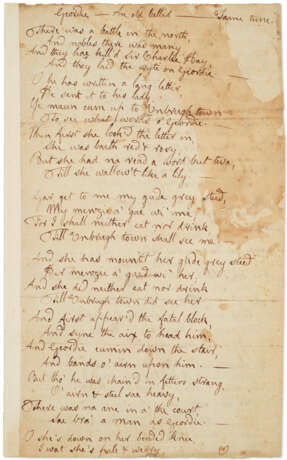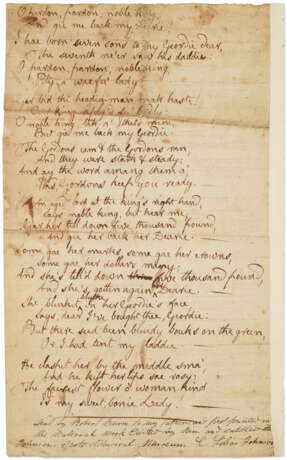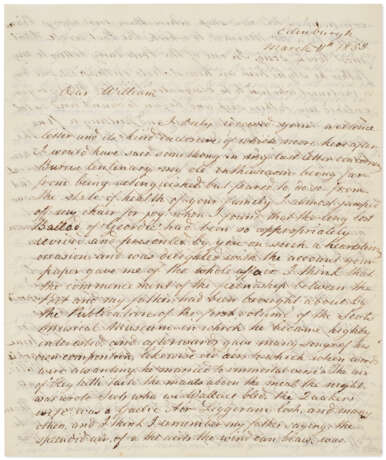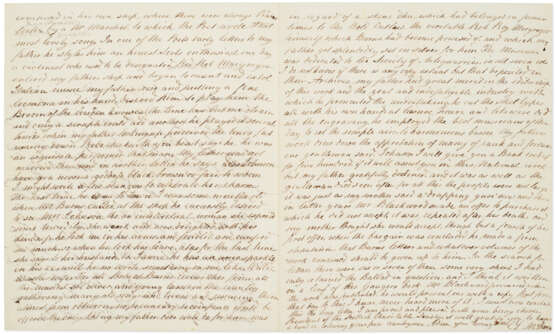ID 1360897
Lot 181 | Geordie, a ballad
Valeur estimée
$ 20 000 – 30 000
60 lines, 2 pages, 328 x 202mm, ink on a single leaf (old stains, smudges to ink on verso, a little wear along creases, paper-binding remnant along margin). [Together with:] Autograph letter signed, "C.L. McPherson," to her son William, Edinburgh, 11 March, 1859. 3 pages, 264 x 220mm, bifolium. Provenance: James Johnson, Edinburgh music engraver, 1750?-1811 (by descent to:) – C. Lilian Johnson McPherson (gifted to: her son William) – John Gribbel (his sale, Parke-Bernet, 22 January 1941, lot 66) – Parke-Bernet, 19 November 1945, lot 93.
But tho' he was chain'd in fetters strang,
O' airn and steel sae heavy,
There was na ane in a' the court,
Sae bra' a man as Geordie.
O she's down on her bended knee,
I wat she's pale and weary,
O pardon, pardon, noble king,
And gie me back my Dearie!
A substantial 60-line autograph manuscript from Robert Burns, for his ballad "Geordie." Notably, a letter from the original recipient's daughter—who knew Burns as a child—accompanies the manuscript and explains the provenance.
The story of the eponymous hero whose lover pleads for his life, "Geordie" is traced to both English and Scottish roots, with the English version first appearing in 17th-century broadsides and the Scottish attributed to Burns's text, which was first published without attribution in James Johnson's Scots Musical Museum in 1792 (Vol. IV, No. 346). Interestingly, in Burns's version the lover is successful in her pleading, which is not always the case in English renditions—the last stanzas read:
An aged lord at the king's right hand
Says, noble king, but hear me;
Gar her tell down five thousand pound,
And gie her back her Dearie.
Some gae her marks, some gae her crowns,
Some gae her dollars many;
And she's tell'd down five thousand pound,
And she's gotten again her Dearie.
She blinkit blithe in her Geordie's face
Says, dear I've brought thee. Geordie:
But there sud been bluidy bouks on the green,
Or I had tint my laddie.
He claspit her by the middle sma',
And he kist her lips sae rosy:
The fairest flower o' woman-kind
Is my sweet, bonie Lady!
Burns and Edinburgh music engraver James Johnson became friends while the poet was visiting Edinburgh in the late 1780s. Johnson had already begun collecting Scottish songs for publication, with the first volume of Scots Musical Museum well-underway. Over the next few years Burns would contribute over 150 original songs to Johnson, as well as many more traditional songs he had collected and re-worked with new lyrical arrangements.
"Geordie" was not immediately included in the Burns canon (though J.W. Egerer's 1946 bibliography notes that Johnson's Museum needed further examination) and subsequently lost track of for a time, until a 1992 article in the journal Studies in Scottish Literature makes note of it. Burns scholar G. Ross Roy writes that the "Geordie" manuscript "has recently turned up with a letter from Johnson's daughter C. Lilian Johnson to her son William, and signed with her married name of McPherson. The ballad as printed, when collated with this manuscript, shows how carefully Johnson followed songs as Burns sent them to him. The letter, from someone who as a child knew Burns, and whose father was one of the poet's intimates, is worth quoting in full." It is followed by a full transcription of the 1859 letter also included in this lot. The manuscript itself is also docketed at the end by her: "Sent by Robert Burns to my father, and first printed in the musical work edited by him and entitled Johnson's Scots Musical Museum. C. Lilian Johnson." [With:] ROY, G. Ross. Studies in Scottish Literature. Columbia: University of South Carolina, 1992.
| Lieu d'origine: | Écosse |
|---|---|
| Catégorie maison de vente aux enchères: | Lettres, documents et manuscrits |
| Lieu d'origine: | Écosse |
|---|---|
| Catégorie maison de vente aux enchères: | Lettres, documents et manuscrits |
| Adresse de l'enchère |
CHRISTIE'S 20 Rockefeller Plaza 10020 New York Etats-Unis | ||||||||||||||
|---|---|---|---|---|---|---|---|---|---|---|---|---|---|---|---|
| Aperçu |
| ||||||||||||||
| Téléphone | +1 212 636 2000 | ||||||||||||||
| Fax | +1 212 636 4930 | ||||||||||||||
| Conditions d'utilisation | Conditions d'utilisation | ||||||||||||||
| transport |
Service postal Service de messagerie ramassage par vous-même | ||||||||||||||
| Modes de paiement |
Virement bancaire | ||||||||||||||
| Heures d'ouverture | Heures d'ouverture
|






